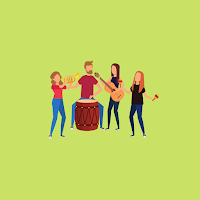Distributed leadership: It's a Dance
The idea: Here are 4 simple analogies to illustrate 'the dance of distributed leadership' or the synergy between learning organizations and its individual team members - Biryani, A River, A Forest and A Band.
‘Learning Organizations’ (coined by Peter Senge) and Distributed Leadership are ideas that have had a strong influence on me as I have learned more about leading schools and building cultures of innovation. Complex organizations like educational institutions are impacted by many moving parts and are set in a fast evolving world. In order for them to thrive, they must be Learning Organizations. Learning Organizations are built on a Shared Vision with a Distributed Leadership structure and strong systems for team learning. You can read more about this powerful idea in Peter Senge’s book ‘The Fifth Discipline’. While I am still deepening my own understanding about Learning Organizations, I will share a few simple analogies that I have used in the past to help my teams understand the idea of a Shared Vision and the workings of a Distributed Leadership structure.
First a quote that sums it up perfectly:
“Leadership is a dance between bringing people together around ideas they care about and pointing a light in a set direction.” - Dr. Justin Reich (Launching Innovation in Schools).
Building a Shared Vision through Distributed Leadership is about achieving a beautiful synergy between the dreams of the organization and also its individual team members. It is about finding ways to further the organizational goals by leveraging the creative strengths of the diverse individuals in the organization.
Let us understand better with a few simple analogies.
 Biryani: The whole can be greater than the sum of its parts
Biryani: The whole can be greater than the sum of its parts
Biryani serves as a great analogy for this point. It is made of several ingredients - the many spices that go into the masala, rice, potato, meat, each with a unique flavor. But when these ingredients come together well, the taste of the resulting, delicious biryani is far better than each of them might have been able to achieve individually. Good leaders build a strong shared vision to help teams recognize this.
A river and its tributaries: There is a place for both, Autonomy and Alignment
Little tributaries merging together into one large river stream is a nice visual representation of ‘the dance of distributed leadership’. Teams and individuals thrive when they have autonomy, but also having alignment between teams is important. This allows the work of each team to contribute towards the more complex, strategic goals of the organization that cannot be achieved without collaboration.
A Forest: See the Forest for its trees
This is a fairly common statement used in the context of Leadership and is usually used when Leaders get so consumed with the details of their plans that they miss the big picture. I like to extend its use to the opposite situation too - when leaders miss the trees. Leaders get so consumed with the goals and priorities of the organization (the forest) that they forget it is made up of individuals (the trees) with important opinions and valuable insights that should also inform the direction of the organization. Shifting between these two perspectives 1) The big picture and what is good for the organization 2) The details and what is good for the individuals that make up the organization is important. Finding a synergy between them is where the magic of good leadership lies.
A Band: Diverse teams can produce more creative work
A Band with just 5 drummers isn’t really a band at all. Each band member has a different skill and together they can create a musical piece or song. The point is similar to the first one, where together we can achieve some things that we cannot individually. But the added layer here is that the diversity in our teams has a special role to play when it comes to creativity and innovation. When people with different sets of knowledge and skill find ways to share ideas and collaborate effectively, novel ideas are born. Hearing perspectives and strategies from beyond one's domain of expertise helps a person expand their ways of thinking. Strong distributed leadership finds ways for diverse teams to have agency but to also bring their individual strengths and expertise together to create something greater around common goals.







Comments
Post a Comment